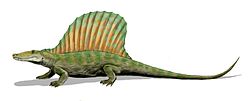| Watongia Temporal range: Middle Permian | |
|---|---|
 | |
| Restoration | |
| Scientific classification | |
| Domain: | Eukaryota |
| Kingdom: | Animalia |
| Phylum: | Chordata |
| Clade: | Synapsida |
| Family: | † Varanopidae |
| Subfamily: | † Varanopinae |
| Genus: | † Watongia Olson, 1974 |
| Type species | |
| †Watongia meieri Olson, 1974 | |
Watongia is an extinct genus of non-mammalian synapsids from Middle Permian of Oklahoma. Only one species has been described, Watongia meieri, from the Chickasha Formation. [1] It was assigned to family Gorgonopsidae by Olson [1] and to Eotitanosuchia by Carroll. [2] Reisz and collaborators assigned the genus in Varanopidae. Based on comparisons of its vertebrae with other varanopids, it was the largest varanopid with a body length of approximately 2 metres (6 ft 7 in). [3] It was a contemporary of its closest relative, the much smaller Varanodon ; the two may possibly represent growth stages of a single animal. [4]





